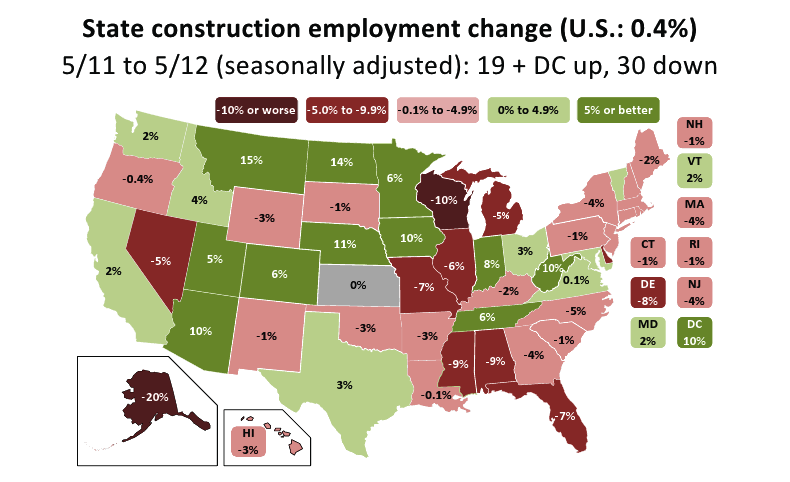In the construction industry, jobs are hard to come by. But a June report released by the Associated General Contractors of America (AGC) indicates that--at least in some states--it’s getting easier. In the report, the AGC finds that 20 states added new construction jobs.
According to AGC data, states with highest percentage of job gains are Montana and Wyoming which posted 12-month growth rates of 15.2% and 13.7%, respectively. At the opposite end of the spectrum are Alaska and Wisconsin with respective losses of 20% and 10.6%.
To find out what’s driving these job losses and gains, I recently caught up with AGC’s Chief Economist, Ken Simonson. In my conversation with Simonson, he highlighted three main drivers behind the current trends in construction employment:
- Low vacancy rates are spurring investment in apartment complex construction.
- The acceleration of natural gas extraction is fueling related construction job growth.
- Manufacturing investment is leading to new manufacturing facility construction.
So what kinds of jobs fit well with these market drivers? Below I’ll profile a few relevant professions currently in demand.
Apartment Complex Construction: Apartment construction requires nearly every kind of construction trade on the job. However, there are a few particular positions that are particularly high demand.
Carpenter: Naturally, carpenters are in high demand as more complexes are built and they’re needed for everything from framing to setting crown molding.
Millwork: The millwork trade is in high demand to produce the doors, crown moldings, window casings, etc. needed to finish an apartment.
Electrician: Electricians that are familiar with multi-family electrical wiring and know how to run standard power distribution to lighting and other outlets in apartments are needed to provide power to an apartment.
Natural Gas Extraction: The growth in natural gas extraction from underground shales is also supporting new construction jobs. The majority of these jobs involve heavy construction or civil engineering.
Earthwork and Excavation: The earthwork industry is needed on natural gas extraction for everything from mining the minerals that are used in extraction to clearing roadway to the drill site.
Civil Engineering: Of course, effectively planning these roadways requires civil engineers that can plan the infrastructure of these projects.
Manufacturing Facilities: Construction jobs are also being supported by the uptick in domestic manufacturing, which is prompting manufacturers to build new facilities in the U.S. As a result, there are two main professions that are in high demand.
Iron Workers: Iron work professionals are needed to put together the large steel frames that facilities require. Within the iron work profession, welders are among the most in demand professions as certified welders are hard to find given that it can take several years to achieve certification.
Electrician: Commercial electricians are needed when constructing a new manufacturing facility because of the need to install power and controls to motors and HVAC systems at the facility--in addition to the need to run power distribution directly from an electrical grid.
If you’re interested in learning more about how these jobs (and skills) fit into the trends I highlighted above, please stop by Software Advice to check out my original article and leave your thoughts here. +
Related Stories
| Aug 11, 2010
'Flexible' building designed to physically respond to the environment
The ecoFLEX project, designed by a team from Shepley Bulfinch, has won a prestigious 2009 Unbuilt Architecture Design Award from the Boston Society of Architects. EcoFLEX features heat-sensitive assemblies composed of a series of bi-material strips. The assemblies’ form modulate with the temperature to create varying levels of shading and wind shielding, flexing when heated to block sunlight and contracting when cooled to allow breezes to pass through the screen.
| Aug 11, 2010
New book provides energy efficiency guidance for hotels
Recommendations on achieving 30% energy savings over minimum code requirements are contained in the newly published Advanced Energy Design Guide for Highway Lodging. The energy savings guidance for design of new hotels provides a first step toward achieving a net-zero-energy building.
| Aug 11, 2010
Perkins+Will master plans Vedanta University teaching hospital in India
Working together with the Anil Agarwal Foundation, Perkins+Will developed the master plan for the Medical Precinct of a new teaching hospital in a remote section of Puri, Orissa, India. The hospital is part of an ambitious plan to develop this rural area into a global center of education and healthcare that would be on par with Harvard, Stanford, and Oxford.
| Aug 11, 2010
Burt Hill, HOK top BD+C's ranking of the nation's 100 largest university design firms
A ranking of the Top 100 University Design Firms based on Building Design+Construction's 2009 Giants 300 survey. For more Giants 300 rankings, visit http://www.BDCnetwork.com/Giants
| Aug 11, 2010
PBK, DLR Group among nation's largest K-12 school design firms, according to BD+C's Giants 300 report
A ranking of the Top 75 K-12 School Design Firms based on Building Design+Construction's 2009 Giants 300 survey. For more Giants 300 rankings, visit http://www.BDCnetwork.com/Giants
| Aug 11, 2010
Turner Building Cost Index dips nearly 4% in second quarter 2009
Turner Construction Company announced that the second quarter 2009 Turner Building Cost Index, which measures nonresidential building construction costs in the U.S., has decreased 3.35% from the first quarter 2009 and is 8.92% lower than its peak in the second quarter of 2008. The Turner Building Cost Index number for second quarter 2009 is 837.







